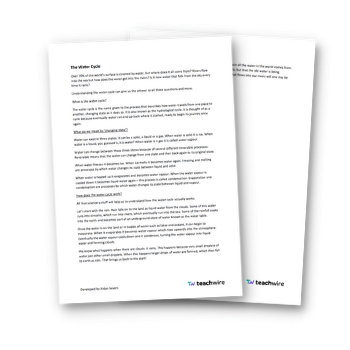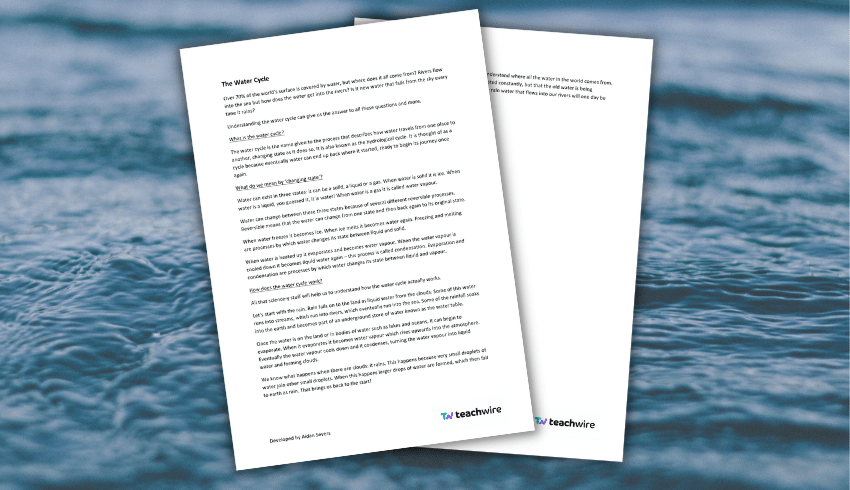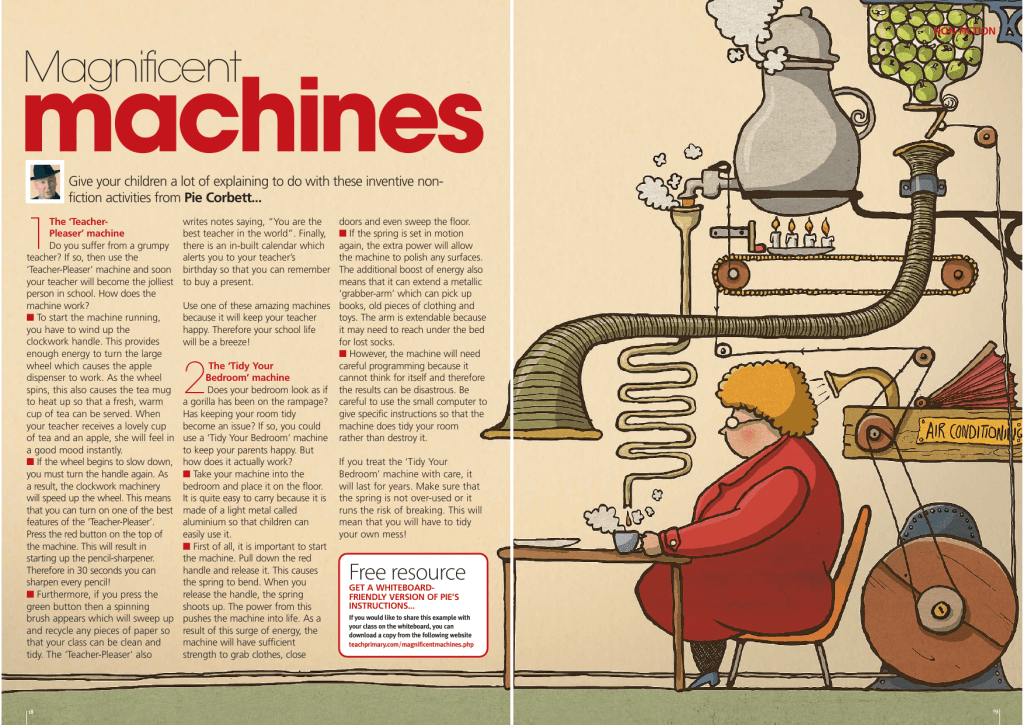Explanation texts KS2 – How to teach its features

Explanation texts are an important part of primary literacy teaching. Try these ideas and get a free model explanation text download here…

- by Aidan Severs
- Education consultant, writer, speaker and former deputy head Visit website

Explanation texts are a versatile and widely adaptable text type to teach in KS2. There are relatively few key features that you need to focus on in order for children to be able to write a good one.
Some of the key features are transferable from or to other kinds of non-fiction writing. And in general, pupils seem to enjoy writing them.
Here we explore effective strategies, engaging activities, and a variety of resources to help you bring explanation texts to life in your KS2 classroom.
What is an explanation text?
An explanation text is a piece of writing whose general purpose is to inform its reader of how something works, and perhaps even how the reader might carry out a process (in the case of a more simplistic form of explanation text: instructions). Whereas a simple information text might tell the reader about the existence of something, an explanation text (otherwise known as explanatory texts) explains how or why that thing came to be in existence.
Children will encounter many non-fiction texts that incorporate explanations, particularly in curriculum subjects such as geography and science.
How and why
As readers they will gain understanding of the ‘how and why’ relating to the subject content. But as they learn to write their own, children become the ones who pass on this knowledge.
Although the writing of explanation texts in KS2 takes some careful and specific teaching, explanations are a part of children’s every day oral, aural and mental experience. Children hear explanations at home and at school, and they explain things to each other and to adults just as much as they have things explained to them.
Even the way we think about how to do everyday tasks is a kind of self-explanation. When it comes to writing explanation texts in KS2, you should point out that pupils therefore have a strong starting point. Use this to capitalise upon the way that you teach them to transcribe such explanations.
What should children write about?
This is a very important question, and one you can’t answer with a blanket statement. In fact, you can only answer it by using your knowledge of the children in your class.
Essentially, pupils can either choose something they know a lot about; or something they’ve made up. If you decide that children should write about something they know a lot about, there are further decisions for you to make.
Children could write about something which is within their own personal area of expertise. Or they could write about something that they have learned at school.
Using personal experience
The first option (writing about something of which they have personal experience) would potentially lead to 30 pieces of unique writing per class. This has the potential to be more factually correct as each piece will be about something that each child knows lots about.
Taking this approach can mean that children are less focused on the content, and more focused on the writing skills you have taught them.
However, with regards to content, it can be more difficult for teachers to provide feedback on. As many schools favour a cross-curricular approach to English, this may not be an option available to you. But it is worthwhile considering as a precursor to a piece of writing that is linked to other subjects in the curriculum.
Writing about what they’ve learned
The second option (writing about something they’ve learned at school) might be more manageable for you as a teacher. But there is the very real problem of children not understanding the content well enough to be able to write about it with sufficient accuracy.
Usually, it will take a number of weeks for children to become secure in the knowledge of a process such as the water cycle. This means that they would only have the best chance of writing about it with confidence after the learning has taken place.
However, it can often be the case that teachers and children are working towards the piece of writing at the same time as learning the content. This leads to confusion.
Taking this approach can mean that children focus more on the accuracy of the subject content (in this case geography and science) rather than the writing skills they are working on.

Fictional non-fiction
The third option is for children to write about something they’ve made up – to write a piece of fictional non-fiction.
Aiming towards this as an outcome means that children can write within the genre without worrying about whether the facts are right or not.
It also allows teachers to focus their assessment solely on the writing skills without getting bogged down in whether or not children are demonstrating accurate science or geography knowledge, for example.
This is where teachers can be really creative. You can link the subject of the explanations to machines found in picture books and short films, made-up creatures and any manner of other things.
Depending on how long you spend on your explanation text teaching sequence, you might be able to progress through each option. You’ll probably start with made-up content, then move to a child’s own interests. You might finish with a piece linked to another curriculum area.
How to write an explanation text in KS2

When thinking about how you will go about teaching a particular kind of writing, it’s always helpful to deconstruct an example text.
Look at the example entitled ‘The Water Cycle’. Let’s think about what we can learn about what teachers should teach and what children should write from this text:
Features of an explanation text
Firstly, look at the main features of the text. These should form the bulk of what you teach and practise throughout the unit.
Paragraphs used to group related ideas
The National Curriculum requires us to introduce Y3 children to paragraphs as a way to group related material.
The example has very short paragraphs, making it easier for the younger reader to understand. This is similar to most non-fiction books aimed at children. So any examples you share from real texts will almost certainly have similarly short paragraphs.
It’s worth remembering that when children hand-write paragraphs of similar length, it will look like a lot more than the word-processed example!

The short paragraphs also demonstrate you can group specifically related ideas. Look at the first paragraph of the Water Cycle text under the subheading What do we mean by ‘changing state’?
It is four sentences long, and the sentences themselves are not long either. The paragraph is very clearly about the three states that water can exist in. The following paragraph is limited to focusing on the idea that water can change between the states.
More explanation text KS2 resources

Introduce explanation texts to your KS2 class with Pie Corbett’s two model texts about the ‘Teacher-Pleaser Machine’ and the ‘Tidy Your Bedroom Machine’.
Grouping information
Both ideas could exist within one paragraph. However, grouping information like this is one way of demonstrating the understanding that readers are likely to comprehend what they are reading better if you clearly present information and it’s not too complicated.
Children often default to disregarding paragraphing altogether, so teaching this skill is important and transferable to most other forms of writing.
A unit of work on writing explanation texts in KS2 is the perfect time to really labour on this objective. This is because it’s perhaps the text type where clarity is of the most importance. If you don’t present the information clearly, the reader may not understand the content properly.
Activities to try
Activities that focus on grouping information are a necessary precursor to children being able to write in paragraphs.
Simply giving the class a set of statements and asking pupils to group them is a good way to begin to do this. You could start with very obviously unrelated statements, such as facts about three different animals which you need to sort according to the animal.
Then move onto statements that are more subtly different in their content: facts about one animal, but some which relate to its eating habits, some about its habitat, and others about its risk of extinction, for example.
You can take this same activity further. Zero in on one animal’s habitat but with facts relating to country, biome and construction.
When children are ready to organise their own content into paragraphs, you can try a similar task, this time using statements written by the pupils themselves.
Being able to physically manipulate the content is key here. And it potentially avoids lots of rewriting at a later stage of the drafting process.
Using sticky notes and an A3 writing frame can work well. These effectively form a first draft once children are satisfied that they have grouped their information correctly.
Title and subheadings to label content
Writing a title (or heading) should be fairly straightforward. Children just need to know that it should summarise what the whole piece of writing is about.
Trending
To ensure pupils are secure with this, try activities like multiple choice questions. Ask children to select the best heading. The other options might be better suited as subheadings which sit throughout the main piece of writing.
You can also look at heading writing for pre-existing explanation texts. This could perhaps be the focus of a reading lesson, once they’ve read an explanation text.
You could see subheadings as optional. However, it’s a statutory requirement of the National Curriculum from Year 3 onwards to teach children to use headings and sub-headings to aid presentation. More importantly, it is a feature that aids in the skill of grouping information.
You can decide on subheadings as a tool prior to grouping information, or once you’ve done the information grouping as a way of defining the group you’ve created.
Either way, the generation of subheadings should be a part of those practice activities. That way, when children come to writing a full explanation text, they have their subheadings already written.
In the example text, there are subheadings for the three main sections of the text, and one for the summary. The introduction sits under the main heading.
Simple structure
This is a simple enough structure that you can teach, and ask children to follow. The example text also structures its content around three main questions.

Using questions as subheadings provides further structure for the content of the paragraphs. Children can focus on ensuring that their content helps to answer the question. And if it does not, they can consider revising and removing that part of their text.
How to write an explanatory text introduction
These are notoriously difficult for children to write, but can build on any prior work they have done about writing introductions and summaries. Many non-fiction text types feature similar beginnings and endings.
You should employ extensive modelling here. Exemplify the writing of introductions and summaries multiple times during the unit.
The basic principles of an introduction for children in KS2 are that it should appeal to the reader’s curiosity and be very clear on what the text is going to be about. You can also consider:
- Go-to stock phrases and sentence structures may come in handy. This is particularly true if you are teaching this text type towards the beginning of KS2.
- Including questions that children might have had themselves, making sure the content connects with the natural curiosity of children. For example, ‘Have you ever wondered…?’
- Facts that the reader will likely already know, coupled with a ‘but’ and a question. This begins to extend the reader’s thinking and to pique their curiosity. For example, ‘Rivers flow into the sea but how does the water get into the rivers?’
- A statement that shows the writer hopes to explain something more to the reader. The example in the text isn’t explicit in this, but intends to put an idea into the reader’s head; the idea that reading the rest of the text would be a good idea. For example, ‘Understanding the water cycle can give us the answer to all these questions and more.’
Phrases to avoid
Phrases to avoid, particularly for children at the upper end of KS2, are the ones that children reach for when they feel stuck. For introductions, these include:
‘This piece of writing is about…’
‘In this text you will find out about…’
‘Read on to find out more.’
Children do not need to write full explanation texts in KS2 in order to practise writing introductions. After studying them in class texts, perhaps linked to their work in other subjects, children can begin to write their own three- or four-sentence introductions to texts about almost anything.
They don’t need to know too much about the content of the rest of the piece of text. That’s because at the practise stage, they aren’t actually going to write it.
How to write an explanatory text summary
Children in KS2 need to understand that a summary should actually explain in just a few sentences what the main learning takeaway is.
As writers, they should attempt to tell the reader what they have just learned, but in fewer words, with less of the explanation. They should focus on the main points only.
Again, some taught phrases and structures will be useful:
- A sentence or two that point out why it is useful to know the content of the explanation text they have just read: ‘Knowing about… helps us to understand…’; ‘It also helps us to see that…’
- A one-sentence summary, that contains the central point of the text, and which might refer back to the questions asked in the introduction: e.g. ‘The rain water that flows into our rivers will one day be rain again!’
Phrases to avoid
Phrases to avoid in summary writing:
- ‘I hope you have learned more about…’
- ‘This piece of writing was about…’
- ‘In summary…’
In terms of practice activities in the lead-up to writing summaries, once children have studied existing summaries, and have seen the teacher modelling how to write one, they could focus on identifying the main points in an explanation text. They can then write a summary for it.
The identification of main points alone is something that pupils often struggle with. Some shared work where they help to identify them, followed by the teacher modelling how to use them to write a summary will be necessary.
When it comes to summarising and identifying main points, and in order to ready the children for writing summaries, practise writing a 20-word summary of something they have learned or read. Next, challenge them to reduce their summary to ten words, then five. This causes pupils to really think about what the key information is.

Technical terms
Encourage children to think through the technical vocabulary that is related to their subject, and to include this in their text.
They need to know that technical terms are usually defined within the text, or in a glossary section. This is to ensure that the reader understands what the words mean.
They should see that an explanation text relies on some technical vocabulary to explain concepts, but that if readers do not understand those words, they may not understand the overall explanation.
In preparation for including technical vocabulary, children should select the words they want to use and to write or find definitions for them. Later on they can work out how to weave these words and definitions into their text.
Grammatical techniques
You may also want to teach specific grammar features for an explanation text, as set out in the National Curriculum. These will vary depending on which year group you are teaching, and which objectives you have already taught.
If selecting grammar-based objectives, ensure that they are suitable for the text type. For example, choosing to teach present perfect tense during this unit is not appropriate to what we’re trying to achieve with the text. However, teaching the use of conjunctions, adverbs and prepositions to express time and cause is essential to explanation writing.
The National Curriculum provides useful guidance as to the type of words you can teach to aid in the writing of explanation texts in KS2.
In Year 3, it outlines that children should work on expressing time, place and cause using conjunctions (when, before, after, while, so, because), adverbs (then, next, soon, therefore), or prepositions (before, after, during, in, because of).
Year 4 advice
If teaching explanation texts in Year 4, the use of noun phrases and fronted adverbials are both suitable teaching points that relate to the text type. So is learning around making the appropriate choice of pronoun or noun within and across sentences to aid cohesion and avoid repetition.
Year 5 advice
In Year 5, you can cover relative clauses beginning with who, which, where, when, whose or that. You can also appropriately use some modal verbs too. Brackets, dashes or commas to indicate parenthesis all have a place in more complicated explanation texts, too.
Year 6 advice
You can use passive voice effectively in Year 6 explanation texts. It’s also possible to use most forms of punctuation taught in Year 6 too.
Explanation text examples
You could adapt this KS2 water cycle explanation text example to include any of the above text features should you wish to use it in your year group.
Assessing explanation texts in KS2
As you teach your children to write explanation texts, keep in mind what your assessment focus is. You want to hone in on the English skills rather than the accuracy of the content.
It’s easy for children to get bogged down in the details of the content. So make sure you reassure them that it’s OK if they get a fact wrong, and that you want them to focus on being able to write well.
Making the right decision in the first place about what the content of the text will be will help hugely with this.
Aidan Severs is an education consultant with over 15 years of teaching experience. Follow him on Twitter @AidanSevers and see more of his work at aidansevers.com










